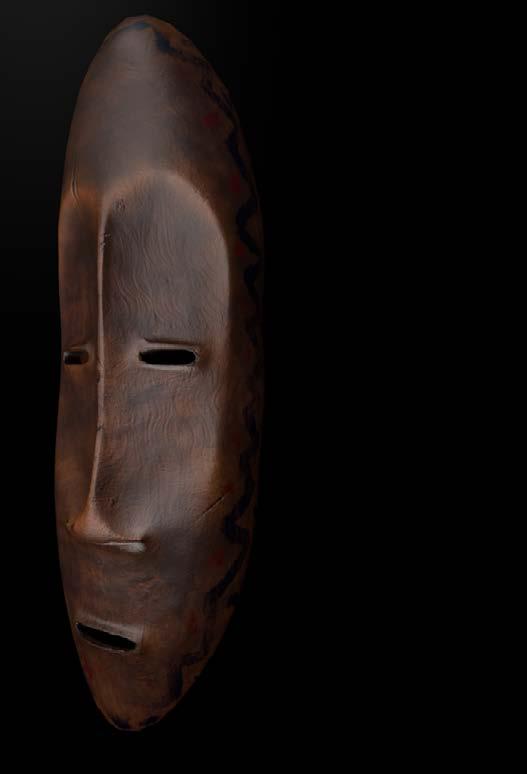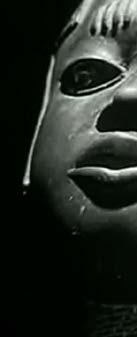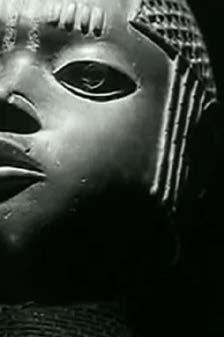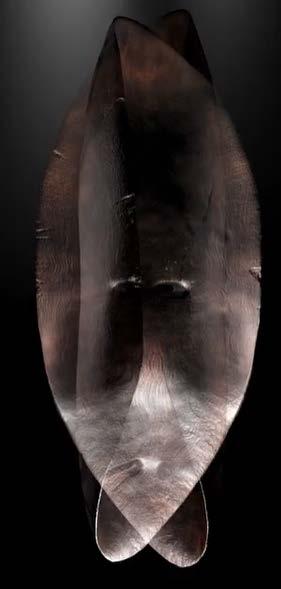aRCHIVE-D?
The digital museum archive as decolonial practice

Andreea Iliescu
Hotel Generation Open Call
The Body - The Mind - The Soul
The BodyThe MindThe Soul

Hotel Generation Open
Call
1 |
N.B. FINAL WORD COUNT 498
Please note that the brief chapter, the quotes, the image captions and bibliography are not included in the word count.

Andreea Iliescu 2 |
“Struggles for decolonization are first and foremost about selfownership. They are struggles to repossess, to take back – if necessary, by force – that which is ours unconditionally and, as such, belongs to us.”
- Franz Fanon

Hotel Generation Open Call The BodyThe MindThe Soul 3 |
Nigerian wooden Fulani mask, hand carved in the artists community north of Lagos, 3D modelled by Andreea Iliescu
References




Andreea Iliescu 4 |
Film stills from ‘Statues Also Die’ directed by Alain Resnais, Chris Marker, and Ghislain Cloquet



Hotel Generation Open Call The BodyThe MindThe Soul 5 |
Film stills from ‘‘Un-Documented: Unlearning Imperial Plunder’’ directed by Ariella Aïsha Azoulay
Brief
1) How can digital technologies be mobilized to address collective forms of resistance against colonial violence through building techno-heritage?
2) How can the digital archive truthfully acknowledge colonial narratives and portray the complexities of colonial legacies?
Keywords: decolonising knowledge, techno-heritage, digital archive, speculative prototype, gamification, animism.

Museums in the Global North are built out of bricks cemented on Imperial ideas. They do not convey the truthful story, but a story of exoticism and othering. ‘aRCHIVED’ critically examines the Western museum collection, proposing an alternative method of digital archiving in the form of an open-world game. The proposal aims to generate techno-heritage as a practice of resistance against colonial violence, where the emancipatory potential of digital technologies will be utilised to re-center knowledge towards the Global South.
Building on the concept of animism - the belief that seemingly inanimate beings and objects all possess a distinct spiritual essence, the project will utilise the West African craft of mask-making as a subject of study.
In Western museums and private collections, masks are viewed as artistic objects mainly appreciated for their aesthetic value, and are stripped bare of their original meaning and function. Historically, African masks played a crucial role in traditional ceremonies and rituals; namely addressing tribal needs in times of war, ensuring a good harvest, or summoning spiritual presences in burial or initiation practices. Hence, masks were therefore not just symbolic; they were seen as “spirit traps” that contained the soul for the benefits of the living.
Andreea Iliescu 6 |
Some masks represent the spirits of deceased ancestors and the wearer of the mask is often believed to be able to communicate to the being symbolized by it, or to be possessed by who or what the mask represents.
The cycle of life, death and afterlife is explored through the lens of the African Mask, where The Body is seen as materialised through the physical object, with its corresponding tangible qualities (materiality, technique, aesthetic etc). The Mind is the craft and knowledge of its Maker, imprinted in the artefact, while The Soul is the object’s spiritual essence, the other-than-human entity embodied within.
I will start by analysing existing archival material not only as a repository of documents, but as a regime of political operations within which media play a crucial role. Digital technologies such as photogrammetry and 3D reconstruction will be compiled with archival and found footage in the game engine to build a repertoire of experiments to be displayed at Arebyte. The gallery space will constitute a physical counterpart to the open-world game through a series of props - in the form of dioramas, with the aim to recontextualize the origin of the artefacts, specifically how the mask makers performed their craft and engaged with their cultural practices.
I believe that issues of representation ethics and bias need to be renegotiated in the digital archive, since the museum as an institution is a place of privilege; as artefacts are looted and displaced from their space of origin, they are deemed inaccessible to most people. I argue that by digitising museum artefacts, one is performing an act of restoration - essentially, an exercise in worldbuilding.
To be human in the digital age is to be able to engage in collective forms of knowledge production. This research contests the institutional erasure of colonial artefacts which constitute the museum archive; as a digital artist, I seek to challenge the balance of distribution of power in the process of archiving.
Hotel Generation Open Call The BodyThe MindThe Soul 7 |
death

WESTERN MUSEUM COLLECTION
Concept diagram illustrating The Body, The Mind and The Soul proposal in regards to the West African mask; each
Andreea Iliescu 8 |
BODY SOUL SPIRIT life
p hy s icalattributes ecnesse Concept
WEST AFRICAN MASK
Hotel Generation Open Call The BodyThe MindThe Soul 9 | MIND SOUL SPIRIT life afterlife embod ied k no w l e gd e namuh-naht-rehto each of the three parts corresponds to a different level in the open-world game.
MASK WORKSHOP
RE-ENACTMENT OF CEREMONY
Film stills from ‘aRCHIVED?’ concept video. For full film, please click here



Andreea Iliescu 10 |


Hotel Generation Open Call The BodyThe MindThe Soul 11 |
Levels
The following moodboards aim to spatialize the three levels, corresponding to The Body, The Mind and The Soul in the video game engine. For the purpose of this example, I have focused on the Fulani mask utilised in burial ceremonies in Nigeria.
LEVEL 1:
Similarly to Chris Marker and Alain Resnais’ film ‘Statues also die’, I argue that objects plundered from imperial exhibitions die and perish, having been decontextualized, displaced and looted from their space of origin. Essentially, this level begins with the object’s symbolic and spiritual ‘death’ - the one of being destined to form part of the Western museum collection. The masks suddenly shift from still objects into animated spirits, becoming personified and having a life of their own; this process leads the audience into understanding the wider context from which they have been displaced. The level constitutes a digital ‘diorama’ - a spatialization of the western museum gallery showcasing its collection. Upon getting closer to each mask, pop-up windows and widgets illustrate important archival documentation about the mask’s origin, accompanied by other objects utilised as counterparts in the ceremony the mask was initially destined for.
This process eventually leads into a new cycle of life of the masks by allowing their stories to be told and re-told.

Andreea Iliescu 12 |


Hotel Generation Open Call The BodyThe MindThe Soul 13 |
Film still from ‘Un-Documented: Unlearning Imperial Plunder’, directed by Ariella Aisha Azoulay
The British Museum African section, The Sainsbury Galleries


Andreea Iliescu 14 |
GUI This
Level One: The Museum Archive Critique, atmospheric moodboard and gamification interaction pop-up widgets
(Graphical User Interface) containing pop-up widgets with background information about West African masks digital archive prototype will be tested utilising the Fulani mask, used in burial ceremonies in Nigeria

Hotel Generation Open Call The BodyThe MindThe Soul 15 |



Andreea Iliescu 16 |
Nigerian mask artisan in his workshop in Lagos
A collection of masks exhibited outside the craftsman workshop
LEVEL 2:
The player then teleports into a West African mask workshop, where the embodied knowledge of its maker is spatialized. This symbolizes life - the craft, the technique and its material qualities are explained, laid out and understood in the context of its space of origin. The embodied knowledge is transmitted over generations, allowing the object’s essence to come back to life. Different levels of interactivity such as pop-up text and animated objects, accompanied by archival and found footage construct the wider picture of the West African mask, recontextualizing and re-assigning meaning to it.
Hotel Generation Open Call The BodyThe MindThe Soul 17 |
The maker will use a special axe, called ‘azde’ to carve and chisel away the general shape and work down into the mask’s features

African tribal artists are always men, and they are trained for several years, either as an apprentice carver. The father shares his skills with his son, continuing their craft through the family line. respectable role in African tribal society, as the creator of such spiritually significant
The wood is especially chosen for its shape and its grain

Andreea Iliescu 18 |
Level Two: The West African mask workshop, illustrating the embodied knowledge and the process of making; moodboard
apprentice to a master line. These artists hold a significant objects.
moodboard of materials and spatial features
is
West African maskmaking is a worldwide known heritage, art and craft
The mask is coloured with materials such as charcoal, mineral pigments and caolin (a powdered clay material)

Hotel Generation Open Call The BodyThe MindThe Soul 19 |
A rough leaf
used to sand and smooth the mask
LEVEL 3:
Finally, the afterlife level is portrayed as a re-enactment of the burial ceremony, where the wearer of the mask - the dancer - becomes a mediator between the living and spiritual world of the dead, a mediator between ancestors and other entities. The mask is generally worn by an especially chosen dancer who gives it life by wearing the mask in a costume that takes on a new identity. The ceremony symbolizes a celebration of life, where the object’s essence takes new other-worldly forms. This level is a spatialization of Northern Nigeria’s roundhut villages (a form of vernacular architecture), where the Fulani tribe settled in the medieval age. The mask’s origin is traced back in space and time, where the rituals it has been destined for are re-enacted.

Andreea Iliescu 20 |


Hotel Generation Open Call The BodyThe MindThe Soul 21 |
Fulani performance dancer preparing before burial ceremony
A series of Fulani and Senufo tribal masks and rituals, West Africa
Within the communities that make them, these masks are primarily spiritual objects that are made to be used. Africans believe that wearing masks and using them during ritualized performances such as weddings, funerals and secret society initiations can connect them with spirits beyond the real world.
During the burial ceremony performance, the wearer of the mask enters a trance-like state that tribes believe will allow them to communicate with ancestors, or to control the forces of good and evil.
The re-enactment ceremony is a digital spatialization (diorama) of a roundhut village in Northern Nigeria; roundhuts are a form of vernacular architecture specific to West Africa.


Andreea Iliescu 22 |
Level Three: The re-enactment of a funeral ceremony of the Fulani tribe in Nigeria. The connection between life and
afterlife moodboard
The baobab is often referred to as the “Tree of Life” as it provides life-sustaining shelter, clothing, food, and water for both humans and animals of the African savanna regions. Every part of the tree is used by humans: The bark is fire resistant and is used for making cloth and rope.
Smudging (the burning of special herbs such as sage) and smoking a special ceremonial pipe may be incorporated into funeral rituals, led by the tribe’s medicine man or spiritual leader.

Hotel Generation Open Call The BodyThe MindThe Soul 23 |
and
The Fulani tribe burial ceremony of a Senufo hunter in Nigeria.
Conclusion
Looted artefacts constituted worlds within worlds for the communities from which they were taken.

My proposal is based on the premise that the digital environment is a profound territory, which, despite it having emerged as a result of military research, it nonetheless offers a highly subversive and emancipatory space. To me, the digital environment is a social practice and a cultural technique which can be mobilized to decolonize and democratize collections, histories, and to activate artefacts and their ghosts. As much as we live in a post-colonial world, we also live in a post-digital world. Thus, the colonial patina is everywhere, as computing is silent but ubiquitous.
As such, through the boundless potential of the digital space, namely the one of video game engines, one can challenge the notion of ‘archiving’ and perform acts of restitution and restoration.
N.B. FINAL WORD COUNT 498
Please note that the brief chapter, the quotes, the image captions and bibliography are not included in the word count.
Andreea Iliescu 24 |
Hotel Generation Open Call The BodyThe MindThe Soul 25 |


Andreea Iliescu 26 |

Hotel Generation Open Call The BodyThe MindThe Soul 27 |
“This object, like millions of others, was part of the fabric of life, not part of the monoculture we now call ‘museum.’ ”
- Ariella Aisha Azoulay
Bibliography
Articles
[1] EPFL News, A conversation with EPFL’s artist-in-residence, Nora Al-Badri https://actu.epfl.ch/news/a-conversation-with-epfl-s-artist-inresidence-n-2/ [accessed 7th February 2023]
[2] EPFL News, Video games have become an aspect of our culture
https://actu.epfl.ch/news/video-games-have-become-an-aspect-ofour-culture/ [accessed 5th March 2023]

[3] Guernica Mag, Ariella Aisha Azoulay interview
https://www.guernicamag.com/miscellaneous-files-ariella-aishaazoulay/ [accessed 15th February 2023]
[4] The Guardian, Should museums return their colonial artefacts
https://www.theguardian.com/culture/2019/jun/29/should-museumsreturn-their-colonial-artefacts [accessed 5th February 2023]
Books
[5] Ariella Aisha Azoulay, Potential History - Unlearning Imperialism
[6] Tim Barringer& Tom Flynn, Colonialism and the object – Empire, material culture and the museum Films
[7] All the world’s memory, dir. Alain Resnais (1956)
[8] Statues also die, dir. Ghislain Cloquet, Chris Marker, Alain Resnais (1963)
[9] Un-documented: Unlearning Imperial Plunder, dir. Ariella Aisha Azoulay (2019)
Andreea Iliescu 28 |
Hotel Generation Open Call The BodyThe MindThe Soul 29 | Bibliography


























